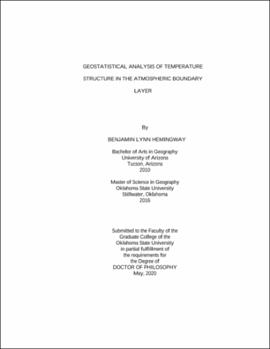| dc.contributor.advisor | Frazier, Amy E. | |
| dc.contributor.author | Hemingway, Benjamin Lynn | |
| dc.date.accessioned | 2020-09-09T21:16:22Z | |
| dc.date.available | 2020-09-09T21:16:22Z | |
| dc.date.issued | 2020-05 | |
| dc.identifier.uri | https://hdl.handle.net/11244/325479 | |
| dc.description.abstract | The lowest portion of the atmosphere, known as the atmospheric boundary layer (ABL), is of considerable importance to weather development at the local scale, but it is among the most difficult portions of the atmosphere to sample. The ABL is characterized by the presence of turbulence, which is the primary means by which heat and moisture are transported. Traditional monitoring techniques such as satellite technology, radar, and weather balloons are unable to sample the ABL at the spatial and temporal scales necessary to resolve the thermodynamic characteristics responsible for local weather development or monitor its rapidly changing structure. Over the past decade, small unmanned aircraft systems (sUAS) have emerged as a sensing methodology well suited to fill the spatio-temporal gaps left by the traditional atmospheric sensing technologies. While numerous studies have collected temperature and humidity data in the ABL, there has been almost no attention given to the determination of optimal spatial sampling strategies for capturing these variables. This research advances spatial science by applying geostatistical analysis techniques to a spatial, continuous random variable to a domain that has seen little attention by spatial scientists. The objective of this research is to apply geostatistics, principally, variogram analysis, to model the vertical spatial structure of thermodynamic variables (e.g., temperature) in the ABL using sUAS. The versatility of the variogram makes it ideally suited for modeling a continuous random variable whose spatial variation is influenced by turbulence. While the variogram was proposed in the 1940s to study turbulence in the spatial dimension, heretofore technology has generally precluded such an application in the ABL, with spatial dimensions instead being inferred from time series. The dynamic sensing capabilities of sUAS allow for an empirical assessment of the spatial structure of small-scale turbulence that, in turn, will allow for better parameterized climate models and weather forecasts. | |
| dc.format | application/pdf | |
| dc.language | en_US | |
| dc.rights | Copyright is held by the author who has granted the Oklahoma State University Library the non-exclusive right to share this material in its institutional repository. Contact Digital Library Services at lib-dls@okstate.edu or 405-744-9161 for the permission policy on the use, reproduction or distribution of this material. | |
| dc.title | Geostatistical analysis of temperature structure in the atmospheric boundary layer | |
| dc.contributor.committeeMember | Stadler, Stephen J. | |
| dc.contributor.committeeMember | Elbing, Brian R. | |
| dc.contributor.committeeMember | Mathews, Adam J. | |
| osu.filename | Hemingway_okstate_0664D_16716.pdf | |
| osu.accesstype | Open Access | |
| dc.type.genre | Dissertation | |
| dc.type.material | Text | |
| dc.subject.keywords | atmospheric physics | |
| dc.subject.keywords | fluid mechanics | |
| dc.subject.keywords | kriging | |
| dc.subject.keywords | remotely-piloted vehicle | |
| dc.subject.keywords | structure function | |
| dc.subject.keywords | unmanned aerial vehicle | |
| thesis.degree.discipline | Geography | |
| thesis.degree.grantor | Oklahoma State University | |
